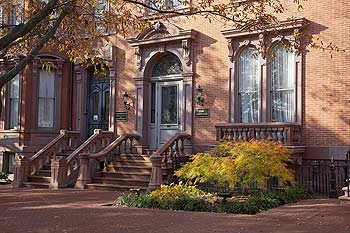West Side Historic Properties
The western side of Lafayette Square is home to a number of historic properties, some of them overseen by GSA. The townhouses, once endangered by the wrecking ball, were acquired by the federal government in 1957. In 1962. First Lady Jacqueline Kennedy successfully lobbied to retain historic character of Lafayette Square and saved the houses from demolition. Between 1963 and 1971, the historic houses were rehabilitated. At the same time, new federal office buildings harmonious with the historic houses were constructed, retaining the area's special character.

The west-side of Lafayette Square, starting, left to right, with the corner of Pennsylvania Avenue and Jackson Place and north up Jackson.
The block begins at 704 Jackson Place, which is part of the President’s Guest House complex, and terminates on H Street at the Stephen Decatur House, designed by Benjamin Latrobe. The plans of the attached houses are typical of the era—three stories with a basement and three bays wide, with off-center entrances on a piano nobile (which is defined as the principal floor of a large house). All houses are of masonry construction, with either sandstone or brick decorative trim and door surrounds.
President's Guest House
(Includes Blair House, Lee House, and 700 and 704 Jackson Place)

Jackson Place sitting room, Blair House, located across from the White House, Washington, D.C.
The President's Guest House, typically referred to as "Blair House." consists of four, visually distinct buildings that have been unified on the interior to serve the needs of visiting dignitaries. The property contains 119 rooms, including 14 guest bedrooms and 35 bathrooms, among other functional spaces. At 70,000 square feet, Blair House is larger than the White House. The property has undergone numerous exterior and interior alterations since its original construction, yet retains its historic appeal. The building at 716 Jackson Place is owned by the federal government and is reserved for the exclusive use by former presidents when they are in town. Purchased by the government in the late 1950s, it became the "Presidential Townhouse" in 1969 by order of President Richard Nixon.The five story building includes two dining rooms, multiple bedrooms, and space for a Secret Service detail in the basement. A four-story building dating from the late 1860's, it was once the home of Supreme Court Justice Oliver Wendell Holmes, Jr.
Trowbridge House
708 Jackson Place
Constructed in 1859 as the residence of William P. Trowbridge, a famous soldier, scientist, and explorer. The house is a typical three-bay example of a mid-nineteenth century attached house with a strong bracketed cornice and sandstone door surround. The grey slate mansard roof was added in the 1880s reflecting changing architectural taste. Trowbridge sold the house in 1869 and, in the early 1900s, it was leased by the United States government for use as office space.
James Alden/Henry Rathbone House
712 Jackson Place
712 Jackson Place was built in 1869 for Admiral James Blair, but was soon sold to Major Henry Rathbone. Rathbone is known for accompanying President Abraham Lincoln to Ford's Theatre on the night of the assassination. Rathbone tried to detain assassin John Wilkes Booth, and was badly wounded in the process. During World War I, the building was home to the Committee for Public Information, and for a brief time it housed the Women’s International League for Peace and Freedom, the oldest women's peace organization in the world. Currently, it houses the President's Commission on White House Fellowships.
The O’Toole Steele, Glover, and Knower-Scott Houses
730, 734, and 736 Jackson Place

734-736 Jackson Place, Washington, DC. 736 is the Marcy/Townsend House.
These houses date from the 1860s to 1870s. These houses maintain the rhythm of the block, while interjecting more elaborate details such as the two-story bay window fronting the Glover House. The ornate door and window surrounds are much heavier and forceful here, particularly in the paired, balustraded windows of the Knower-Scott House.
The Marcy/Townsend house, as the property at 736 Jackson Place has become to be known, is rich in historical and architectural associations. The original Italianate row house was skillfully reworked to the designs of the prominent firm of Carrere and Hastings in 1895. A two-story rear addition, measuring 16 by 29 and a half feet, was made at this time, at a cost of (then) $12,000. The rear addition appears to have contained a ballroom.
President Theodore Roosevelt resided at the Marcy/Townsend house during the White House renovation in 1902. Roosevelt didn’t stay long, spending the summer with his family in Oyster Bay, New York. He returned after an accident with a streetcar in Pittsfield, Massachusetts. The President conducted executive business and held cabinet meetings at the residence.
Decatur House
748 Jackson Place
A fine example of a Federal-period townhouse, Decatur House was built in 1818 by U.S. naval hero Commodore Stephen Decatur and was the first private home on the square. It has been the residence of several distinguished diplomats and political figures since then. Decatur House stands out for another painful, powerful reason. Decatur House is one of the few remaining examples of slave quarters in an urban setting. Today, the National Trust for Historic Preservation operates the residence as an historic house museum. The White House Historical Association, which makes its home here, was founded by First Lady Jacqueline Kennedy.

 U.S. General Services Administration
U.S. General Services Administration


